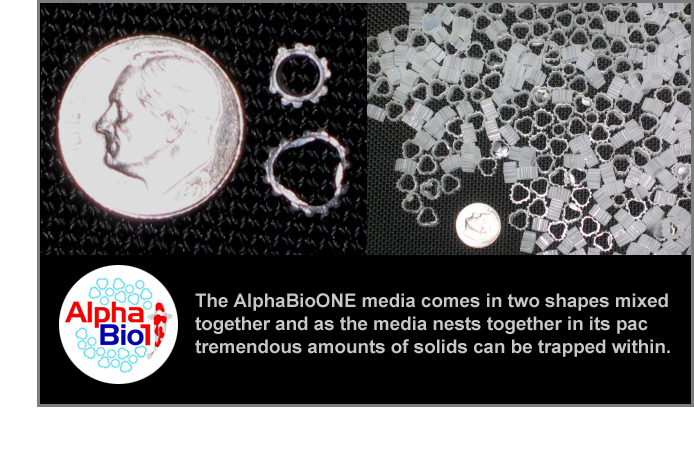|
The Origins of the AlphaONE
The AlphaONE was first conceived over 3 years ago. About 2 years it was tested by about 60 willing participants, consisting of dealers and pond owners. Some of these were new pond owners and many were previous owners of different types of bead filters. In two years of testing the AplhaONE received "0" negative comments. The responses were unanimous: "We Love It!"
What Makes It Different from a Bead Filter?
It can go for greatly extended times before flow slows down. People have reported going for a month (with only a 2.5 model) with no slow down in flow or rise in pressure of the AlphaONE unit. (we do not advocate going for a month before backwashing, the best thing for your fish and your water quality is to backwash the filter often and remove the debris before it breaks down biologically.)
How Does It Do This?
To answer this we have to understand the difference between bead filters and how they trap solids and how the AlphaONE accomplishes this task. Bead filters trap solids in the first few inches of the bead pac (causing clogging, flow disruption and pressure rises in the vessel) while the AlphaONE with its uniquely designed AlphaBioONE media stops the debris evenly through out the pac (resulting in greater flow, less head or back pressure, less maintenance.) The polishing ability of the filter is one it's most desirable features, based upon comments that into us from the field.
The AlphaBioONE media was specially designed for this filter and this filter only. It is not something borrowed from another industry and used in the filter. Its design is unique in that it was not designed with "cross hairs" as some other specialty types of media use. Those "cross hairs" can collect and hold debris until it becomes anaerobic. With the AlphaBioONE media there are no hidden areas for anaerobic bacteria, to harbor and stagnate, only beneficial bacteria. Take a look at the AlphaBioONE media and you'll see for yourself.
 The AlphaBioONE media comes in two shapes mixed together and as the media nests together in its pac tremendous amounts of solids can be trapped within the pac without going anaerobic and still function biologically to perform its second job of nitrification. The solids are easily dispersed when the media agitator is engaged to break up the pac and release the solids out to backwash. Each shape has specially designed ridges around the outside to promote beneficial bacterial growth, but not so long as to cause the media to interlock. Interlocking media, used on some filters, does not come apart when agitated. The shorter, more optimal ridge feature was carefully designed and tested to make sure the filter would function perfectly in the long run. The AlphaBioONE media comes in two shapes mixed together and as the media nests together in its pac tremendous amounts of solids can be trapped within the pac without going anaerobic and still function biologically to perform its second job of nitrification. The solids are easily dispersed when the media agitator is engaged to break up the pac and release the solids out to backwash. Each shape has specially designed ridges around the outside to promote beneficial bacterial growth, but not so long as to cause the media to interlock. Interlocking media, used on some filters, does not come apart when agitated. The shorter, more optimal ridge feature was carefully designed and tested to make sure the filter would function perfectly in the long run.
Quicker Cycling Than Bead Filters
It has been reported by many in the field that the AlphaONE has quicker cycling than bead filters. Some reports of 10 - 14 days have been reported. Compare this with 4 - 8 weeks with most bead type filters.
|